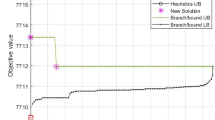Abstract
In order to enhance product competitiveness, customer satisfaction, and achieve quick response, it is common now for enterprises to become members of supply chains. In this paper, a replenishment policy for supply chain was optimized. It is a dynamic lot-sizing problem with deterioration. Most historical literatures consider deteriorations of end products. In practice, many raw materials possess significant deterioration effects, such as fishery and agricultural products. Therefore, this paper proposed a dynamic lot-sizing problem with deteriorating raw material. The point for this problem is to achieve a trade-off between excessive stocks and material deficiency. This paper proved that the proposed problem is NP-hard, and some properties of the proposed problem were also analyzed. Recently, techniques of artificial intelligence are becoming more and more mature, and are widely applied in various fields. In this paper, an ant colony optimization based on those properties was developed.
Access this chapter
Tax calculation will be finalised at checkout
Purchases are for personal use only
Preview
Unable to display preview. Download preview PDF.
Similar content being viewed by others
References
Lee, H.L., Padmanabhan, V., Whang, S.: The bullwhip effect in supply chains. Sloan Management Review 38(3), 93–102 (1997a)
Lee, H.L., Padmanabhan, V., Whang, S.: Information distortion in a supply chain: the bullwhip effect. Management Science 43(4), 546–558 (1997b)
Chen, F., Drezner, Z., Ryan, J.K., Simchi-Levi, D.: Quantifying the bullwhip effect in a simple supply chain: the impact of forecasting, lead times, and information. Management Science 46(3), 436–443 (2000)
Rogers, J.: A computational approach to the economic lot scheduling problem. Management Science 4(3), 264–291 (1958)
Moon, I., Silver, E.A., Choi, S.: Hybrid genetic algorithm for the economic lot-scheduling problem. International Journal of Production Research 40(4), 809–824 (2002)
Jensen, M.T., Khouja, M.: An optimal polynomial time algorithm for the common cycle economic lot and delivery scheduling problem. European Journal of Operational Research 156(2), 305–311 (2004)
Wagner, H.M., Whitin, T.M.: Dynamic version of the economic lot size model. Management Science 5(1), 89–96 (1958)
Lee, C.Y., Cetinkaya, S., Jaruphongsa, W.: A dynamic model for inventory lot sizing and outbound shipment scheduling at a third-party warehouse. Operations Research 51(5), 735–747 (2003)
Jaruphongsa, W., Cetinkaya, S., Lee, C.Y.: Warehouse space capacity and delivery time window considerations in dynamic lot-sizing for a simple supply chain. International Journal of Production Economics 92(2), 169–180 (2004)
Özdamar, L., Birbil, S.I.: Hybrid heuristics for the capacitated lot sizing and loading problem with setup times and overtime decisions. European Journal of Operational Research 110(3), 525–547 (1998)
Smith, L.A.: Simultaneous inventory and pricing decisions for perishable commodities with price fluctuation constraints. INFOR. 13(1), 82–87 (1975)
Friedman, Y., Hoch, Y.: A dynamic lot-size model with inventory deterioration. INFOR. 16(2), 183–188 (1978)
Hsu, V.N.: Dynamic economic lot size model with perishable inventory. Management Science 46(8), 1159–1169 (2000)
Hsu, V.N.: An economic lot size model for perishable products with age-dependent inventory and backorder costs. IIE Transactions 35(8), 775–780 (2003)
Garey, M.R., Johnson, D.S.: Computer and Intractability-A Guide to the Theory of NP-Completeness. W. H. Freeman and Company, New York (1979)
Dorigo, M.: Optimization, learning and natural algorithms. Ph.D thesis, Politecnico di Milano, Italy (1992)
Hiroyasu, T., Miki, M., Ono, Y., Minami, Y.: Ant colony for continuous functions. The Science and Engineering, Doshisha University, Japan (2000)
Author information
Authors and Affiliations
Editor information
Editors and Affiliations
Rights and permissions
Copyright information
© 2009 Springer-Verlag Berlin Heidelberg
About this paper
Cite this paper
Wong, JT., Chen, KH., Su, CT. (2009). Replenishment Policy with Deteriorating Raw Material Under a Supply Chain: Complexity and the Use of Ant Colony Optimization. In: Yang, J., Ginige, A., Mayr, H.C., Kutsche, RD. (eds) Information Systems: Modeling, Development, and Integration. UNISCON 2009. Lecture Notes in Business Information Processing, vol 20. Springer, Berlin, Heidelberg. https://doi.org/10.1007/978-3-642-01112-2_15
Download citation
DOI: https://doi.org/10.1007/978-3-642-01112-2_15
Publisher Name: Springer, Berlin, Heidelberg
Print ISBN: 978-3-642-01111-5
Online ISBN: 978-3-642-01112-2
eBook Packages: Computer ScienceComputer Science (R0)




